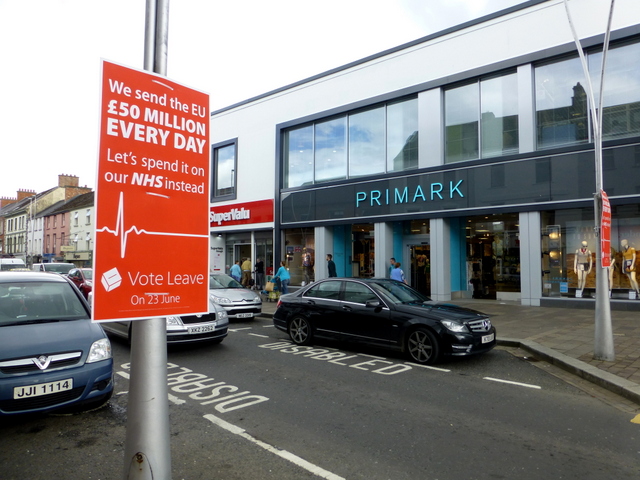London is often described as the most multi-ethnic and diverse city in Europe. Its residents hail from all across the world: former Commonwealth countries like India, Bangladesh and Australia, fellow member states of the European Union and other nations. It’s full of different languages and as many different kinds of cuisine.
According to the census, although the majority of Londoners were born in the United Kingdom, some of the largest groups born outside the UK include India, Poland, Bangladesh, Romania and Pakistan.
Whenever I visit the British capital, I stay with a friend in Wood Green in North London. Twenty minutes from King’s Cross Station you can find a Polish supermarket close to a Jamaican eatery next to an Indian restaurant and close to a Turkish grill. Many Londoners take pride in their multi-ethnic and multi-cultural city.
But with Brexit—Britain’s exit from the European Union—looming on the horizon and edging closer to the October 31 deadline for the government and the EU to agree on a final deal, many are asking how the changes will affect London, a city which has so long marketed itself as a global hub. To understand how Brexit and migration are linked and what Brexit could potentially mean for future migration movements, it is worth stepping back in time to 2004.
Fifteen years ago the United Kingdom opened its borders to Polish citizens after Poland gained EU membership. In contrast to other countries, the UK (together with Sweden) immediately allowed Polish migrants to enter its labor market. It drew some protests, but these were quickly overshadowed. Since then the Polish diaspora in the UK has grown substantially and Polish night clubs and supermarkets have popped up across cities and towns. While studying for my bachelor’s degree I worked as a waitress in an upscale hotel restaurant in Bristol, in the west of England, and customers, unable to place my accent (I’m German, but it’s often described as “international English” with a mixture of German, British, American and other bits and pieces thrown in), often assumed I was from Poland. Polish workers had become largely synonymous with low-skilled jobs in hospitality, construction and service work.
Twenty minutes from King’s Cross Station you can find a Polish supermarket close to a Jamaican eatery next to an Indian restaurant and close to a Turkish grill.
Later on, the United Kingdom labor market opened up to other citizens of the EU A8 countries—eight of the ten countries that joined the European Union in 2004, namely the Czech Republic, Estonia, Hungary, Latvia, Lithuania, Poland, Slovakia and Slovenia. Remaining restrictions on labor market access for Bulgarian and Romanian citizens were removed across the EU in January 2014, but EU migrants in the UK had long been associated with Eastern Europe.
The immigration of citizens from some of these new European member states is still hotly debated across the European Union, and pundits and conservative-leaning academics alike have questioned whether it is EU enlargement and the resulting opening of borders that have been challenging the legitimacy of the European Union. They have decried “welfare tourism” without ever offering any real evidence for it and have initiated various programs to reduce migration numbers, including migrants from the European Union. These efforts came to fruition during the Brexit referendum when a small majority of voters tilted the outcome in favor of the Leave campaign.
Almost half of all Leave voters surveyed for the post-Brexit Ashcroft Polls identified that decisions about the UK should be made in the UK as the primary reason for their vote. One third expressed concern about migration and saw Brexit as an opportunity to regain control over both immigration and the country’s borders.
Immigration had become an issue a few years before, when in 2015 the number of refugees increased due to the civil war in Syria. But the EU vote was about more than just immigration: it was about perceived European overreach that had been massively overplayed in the media and by some politicians, and summarized as an attempt to get British sovereignty back.
Meanwhile, Remain voters were often driven by a vision for Europe that did not go beyond economic factors, jobs and prices as encapsulated in the cherished “single market” which enshrined the free movement of goods, capital, services and labor. This was a view I experienced firsthand when I attended a workshop on the European Union for German and English young professionals in the summer of 2014. The question was posed whether the EU needed substantial reforms, a salient idea to explore at a time when anti-EU sentiments were starting to become increasingly mainstream and talks about a potential referendum were in the early beginnings.
All of the participants were strongly pro-Europe and most of us had connections to both the UK and Germany. But there was a sharp divide between the English and German participants on what kind of European Union they envisioned. Was it a politically or financially more integrated European Union or one that emphasized economic cooperation and reduced EU integration in other fields? The answer revealed an interesting dynamic. While both sides agreed on more European cooperation on many specific policy issues, when it came to the broader vision for the future of the European Union, English participants were in strong favor of more economic cooperation and an emphasis on the single market, while German participants spoke favorably of more increased legislative integration and more cooperation across policy areas.

In a similar sense, post-Brexit voter studies have repeatedly shown that even Remain voters have a relatively weak attachment to the European Union and EU identity, the extent to which an individual identifies with Europe in both a cultural and political sense. The Ashcroft Polls taken after the Brexit vote showed fewer than one in ten remain voters (9%) cast their vote driven by a strong attachment to the European Union and the history, culture and traditions Europe shared. British people say they are “going to Europe” when flying anywhere else on the continent.
To understand the above-mentioned salience of immigration in the EU referendum, we have to place it within a larger environment of increasingly restrictive immigration policies in the United Kingdom. There was the so-called Windrush Scandal which led to the wrongful deportation of 83 British citizens who came to the UK from the Caribbean between 1948 and 1970 to help overcome labor shortages. The controversial “hostile environment” policy which was implemented by the Conservative government in 2014 and has sought to increase immigration checks targeting undocumented migrants and which is directly tied to the Windrush Scandal. And income thresholds have been introduced to curtail migration from outside of the European Economic Area (EEA) and Switzerland by imposing strict financial minimums that have to be met to be allowed to bring non-EEA spouses or to be granted a Tier 2 work-permit for non-EEA citizens. These are just a few elements of the UK Conservative Party’s push to reduce immigration to the “tens of thousands”—an arbitrary number that the party has repeatedly identified as its net migration goal.
Conservative-leaning academics have questioned whether it is EU enlargement and the resulting opening of borders that have been challenging the legitimacy of the European Union.
These efforts are by no means new. The post-war immigration system quickly saw restrictions on the immigration of non-white members of British colonial territory. The Commonwealth Immigrants Act passed in 1962 included employment and skill requirements and was followed up by more restrictive immigration acts until primary immigration from Commonwealth countries was reduced to those with a work permit or parents/grandparents born in the UK.
What we have witnessed recently is a renewed attempt to reduce the number of immigrants in the UK. The family income threshold initiated in July 2012 requires UK citizens and settled residents who want to bring a non-European Economic Area partner to the UK to have a combined income of at least 18,600 British pounds sterling annually. The threshold increases if people want to bring their children as well (GBP 3,800 for their first child and GBP 2,400 for each child after that.) To be granted a general work visa (Tier 2), applicants need to earn at least GBP 30,000 a year (with the exclusion of nurses from that threshold given concerns that the national health system would become even more understaffed). Given the current average income of 28,677, this has had a disastrous effect for those who have long lived in the UK but who do not meet those thresholds. There are also countless stories of families unable to reunite if only one spouse is working and they are working in low-skilled jobs.
Exceptions are hardly granted, even in cases of medical need and emergencies.
This threshold was quickly followed up by the British government in 2015 and 2016 issuing restrictions to EU migrants’ access to welfare which were tightened in 2014 after Bulgarian and Romanian citizens were able to join the UK labor market.
One of the most controversial policies so far emerged at roughly the same time. The hostile environment program was implemented by 2014 and 2016 immigration acts and incorporates different kinds of immigration checks to control access to public services and communities and facilitate data sharing.
There are also countless stories of families unable to reunite if only one spouse is working and they are working in low-skilled jobs.
Suddenly providers of basic services like the NHS as well as landlords and employers had to conduct immigration checks and schools became part of a vast data-sharing program. Human rights organization Liberty has criticized the program for embedding immigration control in the heart of the UK’s public services and communities and undermining the human rights of undocumented immigrants in the UK. Liberty says these controls marginalize them further as they are prevented from accessing housing, healthcare, education, work, bank accounts, benefits and even driver’s licenses. The Guardian newspaper has criticized the policy for being inhumane towards already vulnerable undocumented migrants.
While similar controls already existed before, the hostile environment policy formalized these. And current UK Prime Minister Theresa May, who just announced her resignation, did not beat around the bush when describing the goal of the policy in 2012. “The aim (of Hostile Environment),” she said, “is to create, here in Britain, a really hostile environment for illegal immigrants.”
At the same time, immigration detention in the United Kingdom continues at a high rate and often under terrible conditions. As a consequence, detained immigrants at Yarl’s Wood immigration detention center—a holding facility for immigrants likely facing deportation—carried out a hunger strike to protect the horrible living conditions they faced.
While discussing the British immigration system, it is crucial to acknowledge that the European Union does not have the best track record on the issue either. The freedom of movement within the region went hand in hand with a shoring up of external European borders. Named “fortress Europe,” activists, academics and journalists have long described how the European Union has led to increased control of the outer borders of the region and a vast data sharing and immigration control machine across the region.
Just a few days after the 2019 European Parliamentary Elections at the end of May, in which the UK participated after the Brexit deadline was postponed once more, nobody knows what the final Brexit deal will look like—or if there will even be one. For now, the UK’s final exit has been postponed—tentatively to the October deadline—and people on both sides of the English Channel are starting to get tired of the Brexit bickering. Given Theresa May’s resignation, reaching a deal on Britain’s future relations with the EU seems even more uncertain.
It is unclear what the effect of Brexit has been on migration. Figures released in late 2018 show that migration from outside of the EU has increased while migration from EU-member states has slowed down significantly since Brexit, even though it is hard to say to what proportion of this was driven by Brexit and the extent to which it was spurred by other factors such as increasing employment opportunities in other EU countries. Although, the number of non-EU migrants in the UK has always been higher.
Studies on anti-immigrant attitudes in the United Kingdom found that the country of origin matters. According to a 2017 study by The Migration Observatory at the University of Oxford, just 10% of those surveyed said that no Australians should be allowed to come and live in Britain compared to 37% who said no Nigerians should be allowed. “Such patterns have sometimes been described as an ‘ethnic hierarchy’ … At the preferred end of the scale are those who are white, English-speaking, Europeans and Christian countries while at the least preferred are non-whites, non-Europeans and Muslim countries.”
The study also found differences in attitudes towards migrants based on migrants’ skill-levels, which are embedded in the ethnic hierarchy. For example, only 5% were opposed to professional workers from India and 6% for professionals from Poland versus 35% of respondents who preferred allowing no unskilled labor from Poland and 42% that were opposed to unskilled labor from India. Opposition to migrants from EU member states like Poland might therefore largely be affected by the skill levels of migrants.
To build on its current efforts to target, restrict and reduce immigration, the British government introduced its post-Brexit immigration plan in late 2018. The plan is expected to officially take force in January 2021 if the UK-EU Brexit negotiations will be concluded and a no-deal Brexit—where the UK crashes out of the European Union—will have been avoided.
This plan is centered around a single skills-based immigration scheme that proposes an eventual 30,000 GDP salary threshold alongside no rights to access the British welfare system and a plan akin to guest worker programs in other countries. EU citizens that have already established residence in the United Kingdom will be able to request residency and vice versa. But tough immigration restrictions will apply to future immigrants and the proposed policy underscores the desire of the current UK leadership to reduce permanent settlement of what it considers low-skilled migrants.
Other areas might change as well: There are concerns about international student enrolment in UK universities and funding for academic and other projects which might affect migration to the United Kingdom as well. How this will affect cities like London whose vibrancy partially depends on its international and cosmopolitan character that brings people from across the globe together is hard to say given the current uncertainty, but it is clear that as of now the UK ruling parties are set to rewrite the country’s immigration rules.



